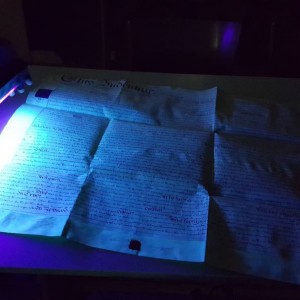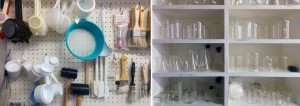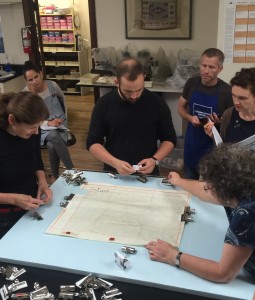Workshop Recap: Parchment Conservation
Earlier this month, I had the opportunity to travel to the International Preservation Studies Center (IPSC, formerly known as the Campbell Center for Historic Preservation Studies) to participate in a 4-day workshop on the conservation of parchment. My nine classmates and I – conservators from a variety of institutions around the country – stayed in IPSC’s dormitory housing in the tiny town of Mount Carroll, Illinois (read about the interesting history of the IPSC campus here) and immersed ourselves in the subject under the guidance of instructor Sheila Siegler, a chemist and conservator with many years of experience treating parchment documents.
From her long experience working with parchment, Sheila brings a wealth of knowledge and a set of strong opinions, but also a refreshing lack of fussiness when it comes to working with a material that has a reputation for being difficult. Along the way she was always very encouraging, reminding us that parchment can be tamed as long as you know what you’re dealing with and accept its quirks and imperfections as par for the course.
We began on the first day with a morning lecture on the history of the use of parchment and how parchment is made. This part is not for the squeamish – the process of turning sheep or calf skin into parchment is a messy business! We also spent some time learning about the chemical structure of parchment and how it deteriorates; as a chemist, Sheila wanted us to understand how and why the parchment would respond to the treatments we performed in class.
We spent the afternoon of Day 1 trying out different ways of examining parchment – under various types of illumination and under different levels of magnification – and comparing the ways that parchment and “parchment paper” behaved under different kinds of stress. Using scraps of historic parchment, modern parchment, and modern parchment paper, we soaked, boiled, and burned samples and recorded the results. Some students had the idea to intentionally disfigure their samples quite severely so that later in the workshop they would have the fun challenge of trying to undo the damage. At the end of Day 1 we broke into pairs and were assigned a large folded historic parchment document (reportedly purchased on eBay) that it would be our responsibility to examine and treat over the rest of the workshop.
Examining a parchment document under ultraviolet illumination. Photo by Kyle Clark.
On the morning of Day 2, we worked on cleaning our parchments and preparing adhesives to use in the afternoon session on parchment repair. Sheila’s preferred cleaning technique is simple – a plain cotton ball, slowly and gently brushed over the parchment surface. Very grimy areas could be cleaned with a swab moistened in water if necessary, but Sheila’s no-fuss approach calls for only as much intervention as is needed; after all, very old documents are bound to show their age, and the idea is not to make them look brand new again, but, for those of us who work in research institutions, to make their contents accessible to researchers.
The adhesive we made is called parchment size and is prepared very simply by slowly heating bits of parchment cuttings in water until the mixture thickens into a mild gelatinous adhesive. We put it to use in the afternoon session, experimenting with it and other adhesives (wheat starch paste and methylcellulose) and different kinds of repair tissues (Japanese paper and a material called goldbeater’s skin, made from ox intestines) to mend tears in parchment. We mixed and matched adhesives and repair materials and made notes on the effectiveness of each combination. We also discussed the types of historic stitched or embroidered repairs that are sometimes seen on parchment, and some students experimented with replicating this type of repair on our sample scraps.
The storerooms at IPSC are a little like a candy store to conservators.
On Day 3 it was time for the most harrowing part of our treatment – humidification and flattening of our parchment documents. Students traded horror stories – their own or second-hand – of parchment treatments gone awry, but in her easy way Sheila urged us to jump in and be brave. We laid down plastic on the table, then moistened absorbent material, then a layer of Tyvek (yes, that Tyvek that you see at construction sites – it protects the document from being saturated but allows water vapor through to gently humidify the object) followed by the parchment and then more Tyvek, another moistened layer, and finally more plastic. After around 30 to 60 minutes, most documents were humidified enough to be ready for flattening, a process that involves placing padded clips close together around the parchment edges and pinning them down (we pinned our to sheets of stiff foam insulation) so that the skin is pulled flat. As it dries, it will “remember” its new flat shape.
Sheila demonstrating how to flatten parchment with the assistance of students. Photo courtesy IPSC.
Sheila was right – it really wasn’t so scary after all, nor quite as time-consuming as it’s sometimes made out to be. The clips can leave some minor distortions along the parchment edges, but those can either be removed through a second, shorter humidification followed by flattening under weight, or they can simply be left alone if one is satisfied with just having removed the major folds. As for the scraps that had been intentionally damaged earlier in the workshop, we tried the same humidification and flattening technique on them and were surprised at how well it worked.
Sheila assessing a student’s flattened parchment. Photo courtesy IPSC.
During the periods of waiting for parchment to humidify or to dry, we did more experimenting, this time with various surface preparations such as those that scribes would have used to prepare parchment for writing upon. We tried an assortment of mild abrasives, liquids, oils, eggs, and combinations thereof to see how they affected the quality of the parchment surface. Someone even found a feather and carved its tip into a nib to make a pen for testing the writing surfaces.
And finally we came to Day 4, when we marveled at our nice flat parchments and did still more experimenting, this time with hinging and matting techniques. Sheila’s preferred method is characteristically simple: a fringe of closely-spaced Japanese tissue hinges all around the document, adhered with wheat starch paste. Using many small hinges (rather than one long one to a side, another common hinging method) allows the skin more room to flex with changes in environmental conditions, which parchment is apt to do.
This workshop was a great experience, and I certainly came away with a better understanding of parchment, as well as the confidence to approach treatment of parchment items in Spencer’s collections.
Angela Andres
Special Collections Conservator
Conservation Services
Tags: Angela Andres, International Preservation Studies Center, parchment, parchment size




